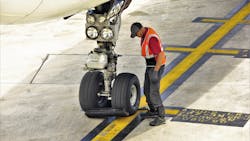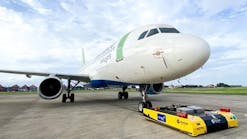Advanced Technologies Help Optimize Aircraft Maintenance in the New Normal
Clearly, the pandemic has disrupted air transportation as we once knew it. It has introduced new “what if” scenarios, supply chain disruptions, and workforce-related challenges. Additionally, it has added new health and safety mandates which are further challenging operations. In addition to requiring new procedures and protocols, there are workforce implications as staff suspected of potential COVID-19 infection must be quarantined, thereby reduced staff resources and further hindering operations. How the industry will transform itself going forward remains unknown, but for now, all stakeholders must function in the new normal. When it comes to critical operations like aircraft maintenance, many airlines are turning to advanced technologies, leveraging Artificial Intelligence, machine learning and proprietary algorithms. These technologies are enabling airlines to better manage the unexpected, beyond those associated with turnaround times and unplanned work, to facilitate the most efficient, cost-effective aircraft maintenance operations.
Aircraft Maintenance and the New Market Challenges
In its latest report, “2020-2030 Fleet and MRO Forecast Update,” the international consulting firm of Oliver Wyman stated that, “It is difficult to overstate the effect of the COVID-19 pandemic on commercial aircraft.” Specifically relating to the aircraft maintenance sector, the forecast goes on to say that “the current trajectory for fleet reductions and lower aircraft utilization would reduce global MRO demand in 2020 by over $48 billion or 53%” with North America and Europe experiencing the greatest impact.
That said, aircraft maintenance is continuing by the airlines and third-party providers and, in fact, despite the reduction in fleet, maintenance procedures have become more arduous. As a result of the pandemic, currently parked planes must be unwrapped at minimum once weekly with engine checks and tests performed, and air conditioning systems operated to prevent humidity from accumulating in the cabin and producing mold which would damage the planes’ flight computers and instrumentation. Other maintenance steps include: moving wheels to prevent their rubber from cracking, and fueling the planes with a blend that prevents the growth of algae in the fuel tanks. Considering the large number of parked aircraft worldwide, it is easy to see how these additional maintenance tasks can tax maintenance staff. Also wreaking a degree of havoc on the maintenance workforce are the new safety protocols in place to prevent the spread of COVID-19. Aircraft maintenance workers, like others in different roles, must comply with social distancing requirements, practice routine cleaning disinfecting of surfaces, use gloves as needed, wash and sanitize their hands frequently and wear masks and other personal protection equipment as required.
In addition to workforce impacts, pandemic prompted lockdowns have compromised the supply chain and exacerbated spare parts supplies. Both finished parts and raw materials to produce the finished parts have been and are being affected thus disrupting maintenance schedules.
Finally, while reduced flights may seem to have mitigated the pronounced shortage of aircraft maintenance and technical personnel that has plagued the industry for years now, that isn’t exactly the reality. There still remains a shortage of maintenance technicians despite the fact that in 2019, more individuals earned their FAA mechanic certifications (i.e., a total of 7,363 certifications) than in the past 17 years. Government assistance such as the United States’ “CARES Act” which provided billions of dollars in relief to businesses including airlines and MROs through its “Payroll Protection Program” and “Air Carrier Worker Support Program” did not solve the aircraft maintenance personnel shortage problem. With aircraft mechanics’ retirements outpacing new entries into the career path, workforce shortages will remain an ongoing challenge for the airlines.
Given all of these challenges, airlines realize that they must avail themselves of any tools and technologies that help them better manage their resources and improve their maintenance processes.
Leading-Edge Line Maintenance Solutions
While these new market challenges do have the airlines’ attention, they have not eliminated challenges to line maintenance that existed before the pandemic. These include:
- Unplanned line maintenance tasks that must be performed on the fly and the associated reassignment of staff to handle them
- Changing flight schedules
- Poor communications and lack of data transparency and sharing between line maintenance control center, cockpit crew and flight operations
- Inaccurate workload projections potentially leading to the need for additional staff and/or heavier than expected work assignments on existing staff which can cause low employee morale
Advanced maintenance solutions help airlines solve several of these problems and those created by the pandemic. In operation, these solutions facilitate improved planning, communications, and data and information sharing. They apply rule-based functions to estimate line maintenance workloads based on existing flight schedules and the number of aircrafts requiring line maintenance. With this data, the optimum work schedules/shifts can be created to provide coverage for the projected work. If the unexpected does occur, the solution’s functionality in analyzing how different “what if” scenarios will affect workloads becomes a critical support. It considers such factors as new aircraft additions, changes in labor agreements, and other workload impacts. Then, it considers worker shifts and skills before generating an optimized staff roster that encompasses key criteria, including: worker skills, personal time off, vacation requests and other factors which can impact the schedule. All of this data is fully transparent and available on a web-based portable access through mobile devices on a 24/7 basis so that all staff can easily access this information and maintain control over their schedules.
Applying the line maintenance optimization software on the day of operations, flight disruptions and the related maintenance requirements they prompt can be quickly addressed. Maintenance staff receive their assignments on their mobile devices and the solution keeps track of their start and finish times on each individual’s maintenance tasks. Supported by the improved communications and data sharing facilitated through the solution, airline maintenance control centers can easily monitor the status of a particular task and each step in the process of completing that task. The performance and productivity of individual maintenance team members can also be assessed using the solution’s data. This information can then be used to determine if and where additional training and/or continuous improvement initiatives should be developed, thereby supporting future optimized performance by maintenance staff.
Driving Measurable Improvements
Advanced line maintenance optimization solutions have been shown to drive measurable improvements across key performance metrics as follows:
- 25% reduction in outstanding minimum equipment list orders
- Up to 30% reduction in maintenance costs
- A 35% increase in productivity using the same number of staff
- Up to 50% reduction in verbal communications
In addition to these statistics, the solution has been shown to optimize aircraft utilization and help improve punctuality, reduce technical delays, and support changing strategic business objectives. Considering the increasing pain points inflicted on airlines today in our new normal, these advanced solutions are providing much needed relief for a core business process.




